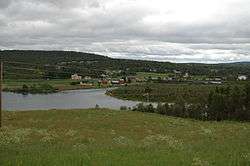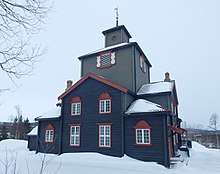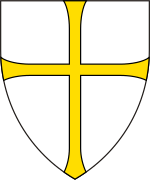Glåmos (municipality)
Glåmos is a former municipality in the old Sør-Trøndelag county in Norway. The short-lived municipality existed from 1926 until its dissolution in 1964. It was located in the northern part of what is now the municipality of Røros in Trøndelag county. It included all the area around the headwaters of the river Glåma and the areas surrounding the northern and western sides of the lake Aursunden. The administrative centre was the village of Glåmos where Glåmos Church is located.[3]
Glåmos herred | |
|---|---|
 View of Glåmos | |
 Sør-Trøndelag within Norway | |
 Glåmos within Sør-Trøndelag | |
| Coordinates: 62.6714°N 11.4288°E | |
| Country | Norway |
| County | Sør-Trøndelag |
| District | Gauldalen |
| Established | 1926 |
| Disestablished | 1 Jan 1964 |
| Administrative centre | Glåmos |
| Population (1964) | |
| • Total | 700 |
| Demonym(s) | glåmosing[1] |
| Time zone | UTC+01:00 (CET) |
| • Summer (DST) | UTC+02:00 (CEST) |
| ISO 3166 code | NO-1643 |
| Official language form | Neutral[2] |
| Preceded by | Røros in 1926 |
| Succeeded by | Røros in 1964 |
The municipality had some old copper mines located in the mountains near the village that used to supply the Røros Copper Works in the nearby town of Røros.
History

The parish of Glåmos was established as a municipality in 1926 when the large municipality of Røros was split into four separate municipalities: Glåmos (population: 983), Brekken (population: 1,098), Røros landsogn (population: 701), and the town of Røros (population: 2,284). During the 1960s, there were many municipal mergers across Norway due to the work of the Schei Committee. On 1 January 1964, the four municipalities of Glåmos (population: 700), Brekken (population: 964), Røros landsogn (population: 482), and the town of Røros (population: 3,063) were all reunited under the name Røros.[4]
Name
The first element of the name is the name of the river Glåma and the last element is os meaning the "starting point of a river". The river Glåma is considered to start near here at the end of the lake Aursunden.[3]
Government
All municipalities in Norway, including Glåmos, are responsible for primary education (through 10th grade), outpatient health services, senior citizen services, unemployment and other social services, zoning, economic development, and municipal roads. The municipality is governed by a municipal council of elected representatives, which in turn elects a mayor.[5]
Municipal council
The municipal council (Herredsstyre) of Glåmos was made up of 13 representatives that were elected to four year terms. The party breakdown of the final municipal council was as follows:
| Party Name (in Norwegian) | Number of representatives | |
|---|---|---|
| Labour Party (Arbeiderpartiet) | 11 | |
| Local List(s) (Lokale lister) | 2 | |
| Total number of members: | 13 | |
| Party Name (in Norwegian) | Number of representatives | |
|---|---|---|
| Labour Party (Arbeiderpartiet) | 9 | |
| List of workers, fishermen, and small farmholders (Arbeidere, fiskere, småbrukere liste) | 4 | |
| Total number of members: | 13 | |
| Party Name (in Norwegian) | Number of representatives | |
|---|---|---|
| Labour Party (Arbeiderpartiet) | 10 | |
| Local List(s) (Lokale lister) | 2 | |
| Total number of members: | 12 | |
| Party Name (in Norwegian) | Number of representatives | |
|---|---|---|
| Labour Party (Arbeiderpartiet) | 10 | |
| Local List(s) (Lokale lister) | 2 | |
| Total number of members: | 12 | |
| Party Name (in Norwegian) | Number of representatives | |
|---|---|---|
| Labour Party (Arbeiderpartiet) | 10 | |
| Local List(s) (Lokale lister) | 2 | |
| Total number of members: | 12 | |
| Party Name (in Norwegian) | Number of representatives | |
|---|---|---|
| Labour Party (Arbeiderpartiet) | 9 | |
| Joint List(s) of Non-Socialist Parties (Borgerlige Felleslister) | 3 | |
| Total number of members: | 12 | |
References
- "Navn på steder og personer: Innbyggjarnamn" (in Norwegian). Språkrådet.
- "Forskrift om målvedtak i kommunar og fylkeskommunar" (in Norwegian). Lovdata.no.
- Thorsnæs, Geir, ed. (2017-12-21). "Glåmos". Store norske leksikon (in Norwegian). Kunnskapsforlaget. Retrieved 2018-01-13.
- Jukvam, Dag (1999). "Historisk oversikt over endringer i kommune- og fylkesinndelingen" (PDF) (in Norwegian). Statistisk sentralbyrå.
- Hansen, Tore, ed. (2016-05-12). "kommunestyre". Store norske leksikon (in Norwegian). Kunnskapsforlaget. Retrieved 2020-02-02.
- "Kommunevalgene og Ordførervalgene 1959" (PDF) (in Norwegian). Oslo: Statistisk sentralbyrå. 1960. Retrieved 2020-04-20.
- "Kommunevalgene og Ordførervalgene 1955" (PDF) (in Norwegian). Oslo: Statistisk sentralbyrå. 1957. Retrieved 2020-04-20.
- "Kommunevalgene og Ordførervalgene 1951" (PDF) (in Norwegian). Oslo: Statistisk sentralbyrå. 1952. Retrieved 2020-04-20.
- "Kommunevalgene og Ordførervalgene 1947" (PDF) (in Norwegian). Oslo: Statistisk sentralbyrå. 1948. Retrieved 2020-04-20.
- "Kommunevalgene og Ordførervalgene 1945" (PDF) (in Norwegian). Oslo: Statistisk sentralbyrå. 1947. Retrieved 2020-04-20.
- "Kommunevalgene og Ordførervalgene 1937" (PDF) (in Norwegian). Oslo: Statistisk sentralbyrå. 1938. Retrieved 2020-04-20.

